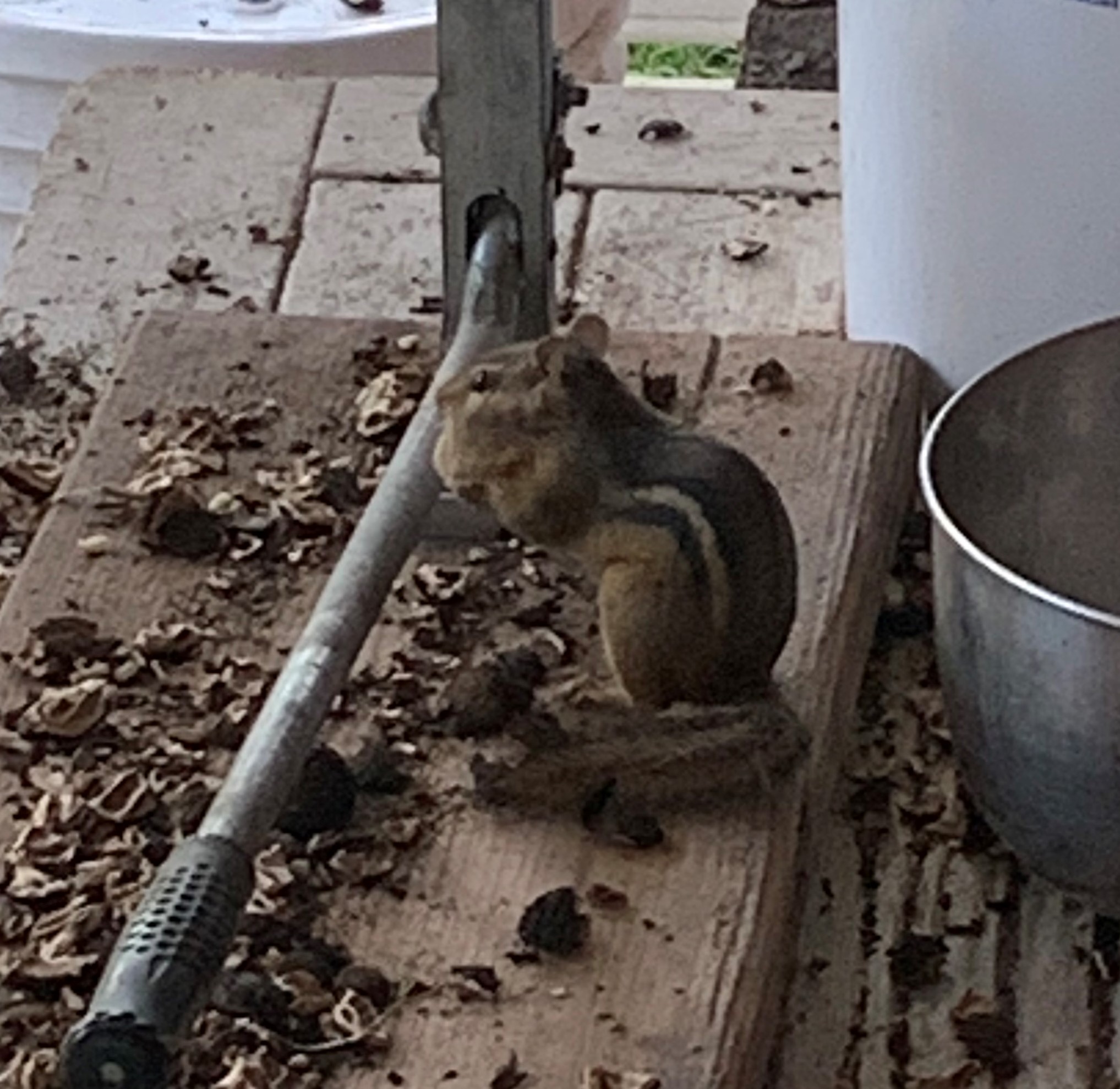Eastern Chipmunks Tamias Striatus
We have a bumper crop of black walnuts, and Bryan has cleaned the hulls off two five-gallon buckets full. The shells are very hard, so I crack them on the front porch with a specially made walnut cracker. It works pretty well, but it flings bits of shell and nutmeat all over the place. I capture the majority in my pan and take it inside to pick the nuts. Meanwhile, a chipmunk boldly climbs onto the nut cracker and looks for the tidbits I missed. She is filling her cheek pouches to bursting with this unexpected harvest.
She lives in a series of tunnels that she has excavated nearby. One of her entrances is near the garage pad, and Dave (my yellow lab) has been monitoring it all summer. He knows there’s something down there and plasters his nose to it every chance he gets. The chipmunk’s tunnels most likely extend underneath the cement, and several entrances ensure that Dave doesn’t catch her coming out. Over time she will expand the burrow even further. The tunnels are two to three inches in diameter. That is a lot of dirt to remove. Unlike some other burrowers, Chipmunk carries the dirt away in her large cheek pockets and spreads it around, leaving the entrances flush with the ground. She hopes this will make them less noticeable by predators.
The tunnels are on two levels with shafts between for easy navigation. Other vertical tunnels serve to drain water so the nest stays nice and dry. The entrance Dave is so fascinated by is only one of several entrances/exits to the burrow. The little critter has been filling the lower level with food for the winter. It’s probably full of walnuts and other smaller seeds. The upper level of the den is where the chipmunk sleeps and is lined with grass and leaves for comfort. The den is about three feet below the surface and may extend up to 30 feet in length with numerous side chambers for storing food, storing waste, birthing pups, and sleeping in. A male came around a couple times this summer, but generally she lives and raises her pups by herself. She’ll have two litters usually, and the pups will leave home when they’re about eight weeks old. At that point they become easy prey for our owls.
The Eastern chipmunk is a rodent related to tree and ground squirrels. She is native to the forests of Eastern United States and Canada, but has migrated westward over the past couple of centuries as habitats changed. Her name comes from an indigenous language which is said to mean “one who descends trees headlong.” Or “head first mouth.” Yes, she can climb trees, although she spends most of her time on or under the ground. She is five to six inches long with a bushy two-three-inch tail and weighs in at a light two to five ounces. She is generally reddish brown with a buff-colored underside. She has a black stripe running down the center of her back and on each side, she has two parallel black stripes with a white stripe between them. She also has tan and brown stripes on either side of her face. Her striping pattern distinguishes her from her cousin the 13-line ground squirrel.
The chipmunk’s face sets her apart. She has little, rounded, stand-up ears and a pointy, whiskery nose. She has big black eyes outlined in tan, and she has cheek pouches that give her a chubby-cheeked appearance. These chubby cheeks drew cartoonists working for Disney to create Chip and Dale, an adventurous chipmunk duo, in 1943. In 1958, Ross Bagdasarian created The Chipmunks Alvin, Simon and Theodore, singing “Christmas Don’t be Late.”
Dave’s chipmunks are out and about during the day, scurrying here and there collecting food, and diving for cover whenever a predator happens by. And everybody that hunts on Owl Acres considers the chipmunk to be fair game. Owls, hawks, weasels, foxes, snakes, raccoons, feral cats and coyotes snack on them. It’s a dangerous world out there. In the wild, her life expectancy is about two years on average, although in captivity she may live to be seven or eight.
Chipmunks usually live alone except when raising pups, which they do twice a year. They’ll aggressively defend their little territories, squeaking and chattering to warn off intruders. They have a vocabulary that includes several different calls. A clucking call warns their neighbors that a predator is nearby. A different chipping call is also used as a warning. These calls warn their neighbors that a hawk or owl is around, and the neighbors join in the clucking, spreading the alarm. They also have a higher-pitched chipping sound and a trill that they employ when they’re being chased. It can be hard to distinguish these calls from bird calls.
This time of year, our chipmunk is gathering up to a gallon and a half worth of acorns, nuts and seeds to fill her winter larder. She’s especially busy in the early morning and late afternoon. She doesn’t truly hibernate. From late October to March, she will sleep for days at a time, waking periodically to snack on her supplies. Her burrow is below the frost line, so she stays warm enough even though her body temperature drops significantly during her sleep times.
Dave’s little chipmunk friends don’t really hurt anything. They might have eaten bulbs or seedlings in the garden, but they also eat slugs and snails and insect larvae. So, I don’t mind sharing some of the walnut harvest with them.
Photo by Author

5 comments
Love the chippies! What a cute picture
Love the chippies!!!!!
Jess says they’re not so much use to her because they don’t truly hibernate. She’s partial to 13 liners
Yes, they are the mainstay of her research!